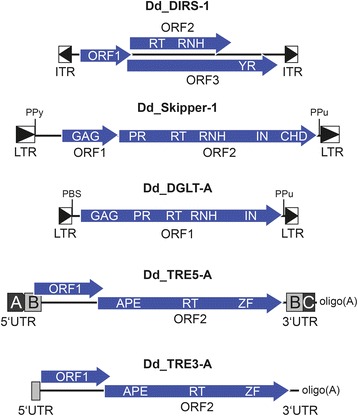Fig. 1.

Overview of retrotransposons in the D. discoideum genome. DIRS-1 is the founding member of the class of tyrosine recombinase retrotransposons. DIRS-1 contains inverted terminal repeats (ITRs) and three ORFs. ORF1 codes for a protein of unknown function. ORF2 overlaps with ORF3 in a separate reading frame and enodes the reverse transcriptase (RT)/ribonuclease H (RNH) domains. ORF3 contains a tyrosine recombinase (YR) core domains at the carboxy terminus. ORF2 could be translated from a genomic DIRS-1 RNA as fusion to the YR domain by a +1 frameshift (not determined experimentally). Skipper-1 is a Ty3/gypsy retrotransposon that contains two ORFs flanked by identical LTRs. Skipper ORF1 codes for a GAG-like protein that includes a CX2CX4HX4C zinc finger-like motif [22]. ORF2 codes for a protease, RT, RNH, integrase (IN), and a chromo domain (CHD). The primer binding site (PBS) that is typical for Ty3/gypsy retrotransposons is replaced by a polypyrimidine sequence (PPy) downstream of the left LTR (Fig. 3). The D. discoideum Skipper-2 element is not listed in this figure because all copies are highly degenerated, but seems to have the same structural organization as Skipper-1. DGLT-A is a Ty3/gypsy retrotransposon that contains all protein functions in a single ORF [17]. The ORF contains a GAG-like protein with a CX2CX4HX4C zinc finger-like signature followed by RT, RNH, and integrase (IN) domains. Note that DGLT-A has no amino-terminal extension of the IN core domain and lacks a CHD. DGLT-A elements have a putative PBS 2 bp downstream of the left LTR (compare Fig. 3) and a polypurine tract (PPu) immediately upstream of the right LTR. Note that there are no Ty1/copia-like elements in the D. discoideum genome. The non-LTR retrotransposon family TRE separates into two subgroups, TRE5 and TRE3, named after their integration preferences upstream or downstream of tRNA genes [29]. All TRE elements contain two ORFs and have the same arrangement of protein domains in ORF2 in the order apurinic/apyrimidinic endonuclease (APE), RT domain, and a zinc-finger domain. The ORFs are flanked by short untranslated regions (UTR), and each element ends with a poly(A) tail of variable length. In contrast to the other TREs, TRE5-A has a modular structure determined by the duplication of the B-module [67]
